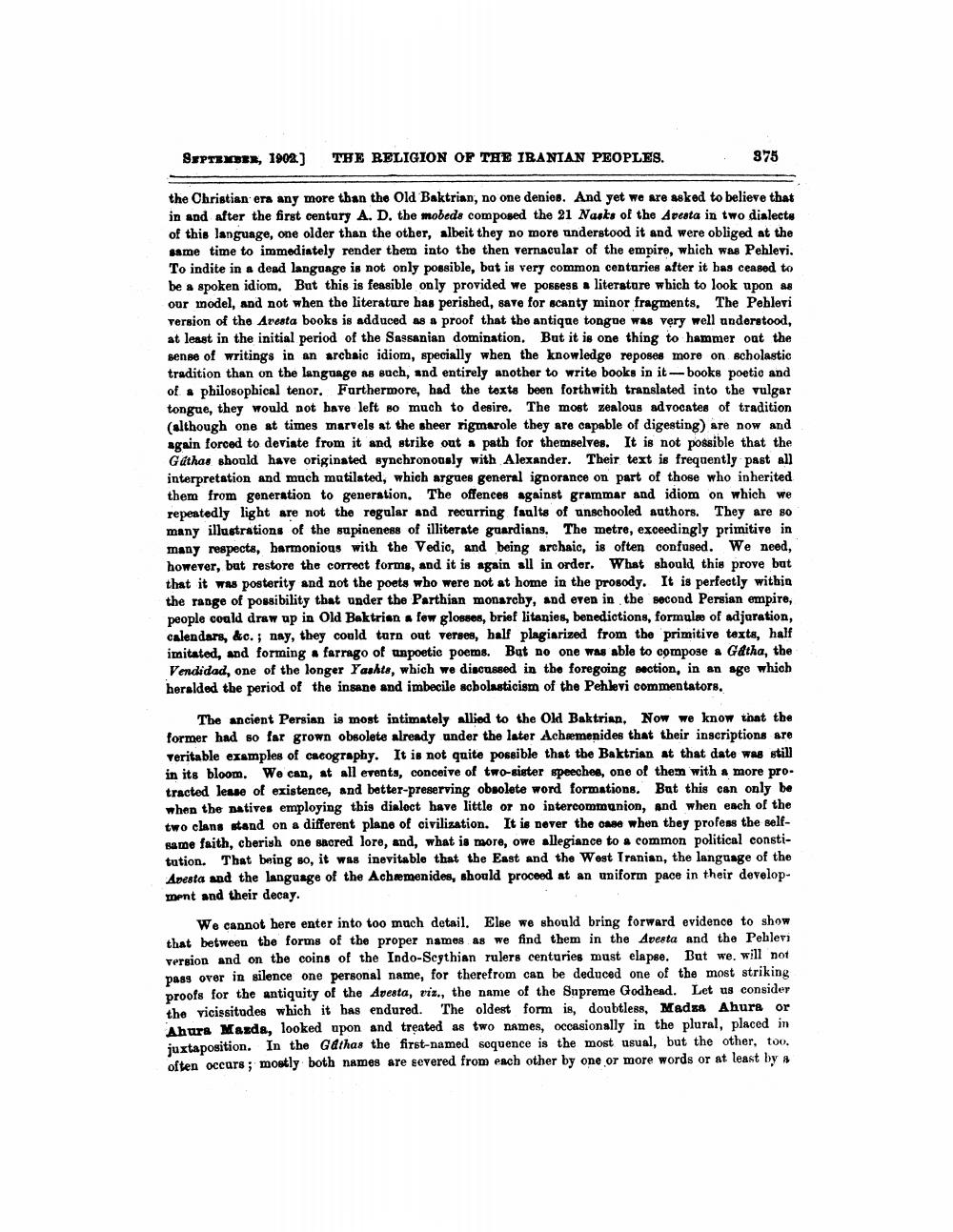________________
SEPTEMBER, 1902)
THE RELIGION OF THE IRANIAN PEOPLES
375
the Christian era any more than the Old Baktrian, no one denies. And yet we are asked to believe that in and after the first century A. D. the mobeds composed the 21 Masks of the Apesta in two dialects of this language, one older than the other, albeit they no more understood it and were obliged at the same time to immediately render them into the then vernacular of the empire, which was Pehlevi. To indite in a dead language is not only possible, bat is very common centuries after it bas ceased to be a spoken idiom. But this is feasible only provided we possess a literature wbich to look upon as our model, and not when the literature has perished, save for scanty minor fragments. The Pehlevi version of the Avesta books is adduced as a proof that the antique tongue was very well understood, at least in the initial period of the Sassanian domination. But it is one thing to hammer out the sense of writings in an archaic idiom, specially when the knowledge reposes more on scholastic tradition than on the language as each, and entirely another to write books in it-books poetic and of philosophical tenor. Furthermore, had the texts been forth with translated into the vulgar tongue, they would not have left so much to desire. The most zealous advocates of tradition (although one at times marvels at the sheer rigmarole they are capable of digesting) are now and again forced to deviate from it and strike out a path for themselves. It is not possible that the Gathas should have originated synchronously with Alexander. Their text is frequently past all interpretation and much mutilated, which argues general ignorance on part of those who inherited them from generation to generation. The offences against grammar and idiom on which we repeatedly light are not the regular and recurring faults of unschooled authors. They are so many illastrations of the supineness of illiterate guardians. The metre, exceedingly primitive in many respects, harmonious with the Vedic, and being archaic, is often confused. We need, however, but restore the correct forms, and it is again all in order. What should this prove bat that it was posterity and not the poets who were not at home in the prosody. It is perfectly within the range of possibility that under the Parthian monarchy, and even in the second Persian empire, people could draw up in Old Baktrien few glosses, brief litanies, benedictions, formulæ of adjaration, calendars, &c. ; nay, they could turn out verses, half plagiarized from the primitive texts, half imitated, and forming farrago of tnpoetic poems. Bat no one was able to compose a Gátha, the Vendidad, one of the longer Yashts, which we discussed in the foregoing section, in an age which heralded the period of the insane and imbecile scholasticism of the Pehlevi commentators.
The ancient Persian is most intimately allied to the Old Baktrian, Now we know that the former had so far grown obsolete already under the later Achæmenides that their inscriptions are veritable examples of cacography. It is not quite possible that the Baktrian at that date was still in its bloom. We can, at all events, conceive of two-sister speeches, one of them with a more protracted lesse of existence, and better-preserving obsolete word formations. But this can only be when the natives employing this dialect have little or no intercommunion, and when each of the two clans stand on a different plans of civilization. It is never the case when they profess the selfsame faith, cherish one sacred lore, and, what is more, owe allegiance to a common political constitution. That being so, it was inevitable that the East and the Wost Iranian, the language of the Apesta and the language of the Achæmenides, should proceed at an uniform pace in their development and their decay.
We cannot bere enter into too much detail. Else we should bring forward evidence to show that between the forms of the proper names as we find them in the Apesta and the Pehlevi version and on the coins of the Indo-Scythian rulers centuries must elapse. But we will not pass over in silence one personal name, for therefrom can be deduced one of the most striking proofs for the antiquity of the Apesta, viz., the name of the Supreme Godhead. Let us consider the vicissitudes which it has endured. The oldest form is, doubtless, Madrs Ahura or Ahura Mazda, looked upon and treated as two names, occasionally in the plural, placed in juxtaposition. In the Gathas the first-named sequence is the most usual, but the other, too. often occars; mostly both names are severed from each other by one or more words or at least by :




